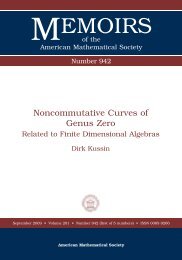University of Paderborn Department of Mathematics Diploma Thesis ...
University of Paderborn Department of Mathematics Diploma Thesis ...
University of Paderborn Department of Mathematics Diploma Thesis ...
Create successful ePaper yourself
Turn your PDF publications into a flip-book with our unique Google optimized e-Paper software.
40 CHAPTER 2. STABLE IDEALSAs a corollary <strong>of</strong> Theorem 2.17 and Theorem 2.27 we obtain the following algorithm tocompute the Hilbert polynomial <strong>of</strong> a stable ideal I.Algorithm 2.29. (Computation <strong>of</strong> the Hilbert polynomial <strong>of</strong> a stable ideal) Let I ⊂ R bea stable ideal and I g = {m 1 , . . . , m r } a set <strong>of</strong> minimal generators <strong>of</strong> I, d i := deg m i thedegree and l i the index <strong>of</strong> the last variable <strong>of</strong> the monomial m i , 1 ≤ i ≤ r.The algorithm proceeds in three steps:Input. I g = {m 1 , . . . , m r }, i.e. the set <strong>of</strong> minimal generators <strong>of</strong> a stable ideal.1. Compute the Hilbert series H R/I (t) <strong>of</strong> R/I, i.e.H R/I (t) = 1 − ∑ ri=1 (1 − t)li · t d i(1 − t) n+1 .2. Compute the reduced Hilbert series ˜H R/I (t), i.e.˜H R/I (t) =∑ ki=0 C i · t i(1 − t) d ,where the numerator does not vanish for t = 1.3. Compute the Hilbert polynomial <strong>of</strong> R/I by using the preceding theorem, i.e.p R/I (z) =k∑( )z + d − 1 − jC j ·.d − 1j=0Output. The Hilbert polynomial p R/I (z) <strong>of</strong> R/I.Pro<strong>of</strong>. (Correctness) The correctness <strong>of</strong> the algorithm follows from Theorem 2.17 andTheorem 2.27.We will now use the algorithm in a concrete example. Recall that in Example 2.26 (iii)we did not prove that the computed ideal has the stated Hilbert polynomial. We now givethe pro<strong>of</strong> by using the new algorithm to compute its Hilbert polynomial.Example 2.30. Let R := K[x 0 , x 1 , x 2 , x 3 , x 4 ], and let I be the unique lexicographic ideal,which we obtained in Example 2.26 (iii), i.e. I = (x 0 , x 5 1, x 4 1x 3 2, x 4 1x 2 2x 6 3). We want to computethe Hilbert polynomial according to the preceding algorithm. Thus, we proceed in the threesteps mentioned above:1. The non-reduced Hilbert series H R/I (t) <strong>of</strong> R/I is1 − (1 − t) 0 · t − (1 − t) · t 5 − (1 − t) 2 · t 7 − (1 − t) 3 · t 12(1 − t) 5 .
















